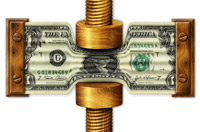It’s the second week since the national dram has been devaluating. The population is quite thrilled about that. Unlike official statements, they know that their incomes are coming from abroad. And the ones who, from here, work abroad don’t make very much. Therefore, the majority of the population is really sorry about the state policy of revaluating AMD. The process of AMD devaluation on the threshold of Parliamentary elections 2007 has many explanations. The majority of explanations are political. Those may be summarized this way, “on the threshold of elections they don’t want to irritate people. Vice versa, they are trying to portend to be nice to them.” (We really appeared in an interesting situation. It’s only enough to slightly lessen the pressure and people are satisfied.) Of course, there are more civilized political explanations. For example, AMD is being devaluated because of the elections. And any type of elections implies certain political instability in the country. No one knows who will come to power. That’s the reason independent financial corporations wish to exchange their money to currency. The possible authors of such explanations are international organizations. We want to prove to them that by devaluating AMD, market relations actually develop in our country. These are the political explanations of the process. Of course there are also economic explanations. For example, it’s known that one of the international corporations in Armenia has started to buy a great amount of currency starting last week. This act raised the demand level of USD and as a result AMD rates shifted down. This is also a civilized explanation, which is quite acceptable for our government. There is also another civilized economic explanation of the process, which however is not quite acceptable for our government. That explanation is based on our economic indexes. The forecasts of 2007 show that our economic tiger is going to be slightly decreased. A dual-digit growth of 2007 was anticipated for Armenia, which had showed dual-digit growth for the past 5 years. In the event of 10% growth the tiger may still be visible. However in the event of 9% the tiger will be replaced by a “tiny tiger” (others may prefer to call it “little cat”). The results of the economic activity of the first quarter of 2007 have already been summed up. Those imply certain serious hazards. The most hazardous motives are of course in the real economic sector. The protocol of the CB of RA 2007 shows that the forecast of the industry sector may turn out to be unrealistic. First they assume that industry rates in the first quarter of 2007 may grow by 4.5%. Later they announced that it has increased by only 1%. The reason is the diamond processing sector, of which rates have fallen by 35% in January-February. For the second quarter of 2007 a 6.5% industrial growth was planned. Now the government yearns after more modest numbers – 3.3%. Within the past year and a half, industry has been a sector that has been humiliating our macroeconomic indexes. Perhaps that is the reason the government is so persistently trying to struggle against that. Instead the construction rates are barely trying to cover the poor rates of industrial developments. Who could ever expect that it would be the CB, which would be the first to announce the retreat of the tiger? By examining the branches of economies, they make quite an interesting forecast about 2007, and quite miserable ones about the first quarter of 2008. “In the event of such processes during 2005, 9-12% GDP is anticipated and in the first quarter of 2008 – 6.5-8.5%.” This is the first one-digit forecast of the past years. And if our CB is not mistaken our tiger won’t be able to survive more than a year. Of course this is a great and sobering present for our society.

